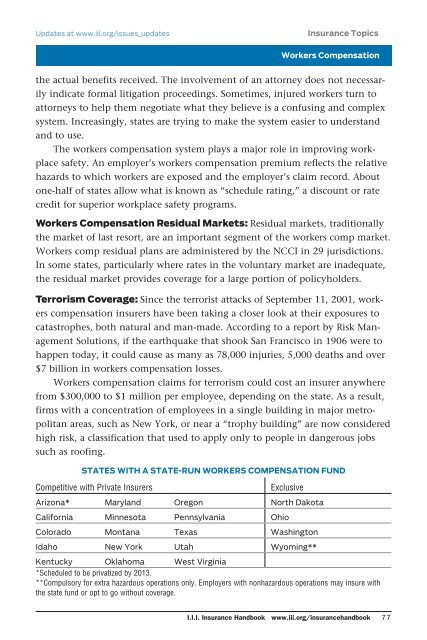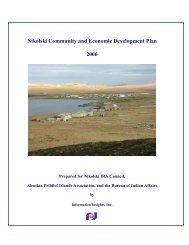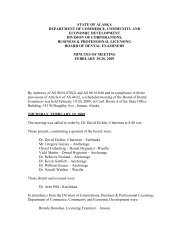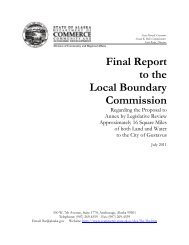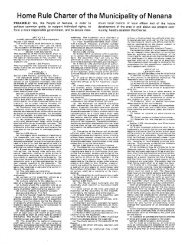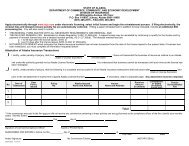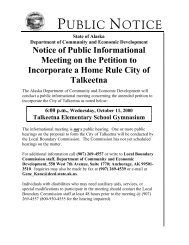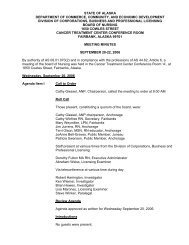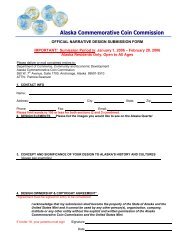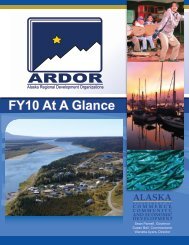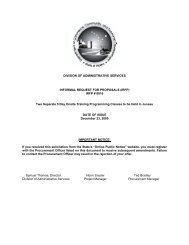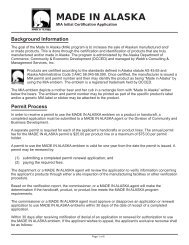Insurance Handbook - Alaska Department of Community and ...
Insurance Handbook - Alaska Department of Community and ...
Insurance Handbook - Alaska Department of Community and ...
Create successful ePaper yourself
Turn your PDF publications into a flip-book with our unique Google optimized e-Paper software.
Updates at www.iii.org/issues_updates <strong>Insurance</strong> Topics<br />
Workers Auto Compensation<br />
<strong>Insurance</strong><br />
the actual benefits received. The involvement <strong>of</strong> an attorney does not necessarily<br />
indicate formal litigation proceedings. Sometimes, injured workers turn to<br />
attorneys to help them negotiate what they believe is a confusing <strong>and</strong> complex<br />
system. Increasingly, states are trying to make the system easier to underst<strong>and</strong><br />
<strong>and</strong> to use.<br />
The workers compensation system plays a major role in improving workplace<br />
safety. An employer’s workers compensation premium reflects the relative<br />
hazards to which workers are exposed <strong>and</strong> the employer’s claim record. About<br />
one-half <strong>of</strong> states allow what is known as “schedule rating,” a discount or rate<br />
credit for superior workplace safety programs.<br />
Workers Compensation Residual Markets: Residual markets, traditionally<br />
the market <strong>of</strong> last resort, are an important segment <strong>of</strong> the workers comp market.<br />
Workers comp residual plans are administered by the NCCI in 29 jurisdictions.<br />
In some states, particularly where rates in the voluntary market are inadequate,<br />
the residual market provides coverage for a large portion <strong>of</strong> policyholders.<br />
Terrorism Coverage: Since the terrorist attacks <strong>of</strong> September 11, 2001, workers<br />
compensation insurers have been taking a closer look at their exposures to<br />
catastrophes, both natural <strong>and</strong> man-made. According to a report by Risk Management<br />
Solutions, if the earthquake that shook San Francisco in 1906 were to<br />
happen today, it could cause as many as 78,000 injuries, 5,000 deaths <strong>and</strong> over<br />
$7 billion in workers compensation losses.<br />
Workers compensation claims for terrorism could cost an insurer anywhere<br />
from $300,000 to $1 million per employee, depending on the state. As a result,<br />
firms with a concentration <strong>of</strong> employees in a single building in major metropolitan<br />
areas, such as New York, or near a “trophy building” are now considered<br />
high risk, a classification that used to apply only to people in dangerous jobs<br />
such as ro<strong>of</strong>ing.<br />
STATES WITH A STATE-RUN WORKERS COMPENSATION FUND<br />
Competitive with Private Insurers Exclusive<br />
Arizona* Maryl<strong>and</strong> Oregon North Dakota<br />
California Minnesota Pennsylvania Ohio<br />
Colorado Montana Texas Washington<br />
Idaho New York Utah Wyoming**<br />
Kentucky Oklahoma West Virginia<br />
*Scheduled to be privatized by 2013.<br />
**Compulsory for extra hazardous operations only. Employers with nonhazardous operations may insure with<br />
the state fund or opt to go without coverage.<br />
I.I.I. <strong>Insurance</strong> <strong>H<strong>and</strong>book</strong> www.iii.org/insuranceh<strong>and</strong>book 77


